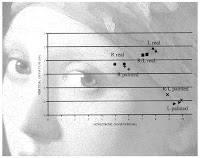 Recently in the year 2006, Devorah Sperber created the art piece, “After Vermeer II,” which is 96” X 100” in size. This art piece became a rendition of Vermeer’s painting, “Girl with a Pearl Earring.” Devorah Sperber is a New York artist [and] has always been fascinated by the science behind vision, curious to understand how viewers experience her artwork (Eye of the Beholder, 2007). In this art piece, Sperber used 5,024 spools of thread on stainless steel ball chains which portray a hanging apparatus. In order to see the painting right side up, a clear acrylic viewing sphere on a metal stand was placed in front of the art piece for people to see the abstract image.
Recently in the year 2006, Devorah Sperber created the art piece, “After Vermeer II,” which is 96” X 100” in size. This art piece became a rendition of Vermeer’s painting, “Girl with a Pearl Earring.” Devorah Sperber is a New York artist [and] has always been fascinated by the science behind vision, curious to understand how viewers experience her artwork (Eye of the Beholder, 2007). In this art piece, Sperber used 5,024 spools of thread on stainless steel ball chains which portray a hanging apparatus. In order to see the painting right side up, a clear acrylic viewing sphere on a metal stand was placed in front of the art piece for people to see the abstract image.
To me, I was amazed at how you can use something so simple, such as spools of thread, from everyday life and resemble it exactly to a famous art piece in history. Sperber first breaks down an original art piece by deconstructing an image into pixels. She then uses reels of thread to represent each pixel because they are available in more than 300 colours and—side –on—appear square, like digital pixels (Eye of the Beholder, 2007). The use of thread creates a contrast between high and low technology, with the brain “sewing” together a digital image (Phillips, 2002). Sperber always works with masterpieces because they are such familiar images, leaving the viewer all the more surprised when they are emerged. The viewing sphere, which is placed in front of the art piece, creates the scientific view of Sperber’s artwork. The disparity between the sculpture seen with naked eye and the same sculpture seen through the viewing sphere is intended to make viewers think more deeply about the act of sight. We do not see the world merely as it is, her pieces remind us; we see the end product of the brain’s information processing (Eye of the Beholder, 2007).
In this case, I love when artist, like Devorah Sperber, can create pieces of art relating to the naturalistic elements and scientific views all in one piece. It shows that she can be flexible with two different ideas and can make them come to real life through simplistic items found in our own household. It takes a person with great interpretation and a deep understanding of formation, color, and abstract ideas to create pieces of art in a different view. At first, I thought to myself, wow this is unique and something that I have never seen before, but then a thought popped into my mind about the art pieces. Even though, I was interested and amazed by Sperber’s work, I thought of how it might be unoriginal because she has taken someone’s painting and turned it into something different, yet still portraying the original image. However after doing further research, Sperber has created many of her own original pieces and the ones that we saw in the BAM was only a glimpse of her artistic career.


Works Cited:
"Eye of the Beholder" New Scientist 193.2595 (2007): 52. Academic Search Premier. EBSCO. Web. 7 Oct. 2009.
Phillips, Patricia C. “Seeing Things.” Art Journal 61.4 (2002): 86. Academic Search Premier. EBSCO. Web. 7 Oct. 2009.















